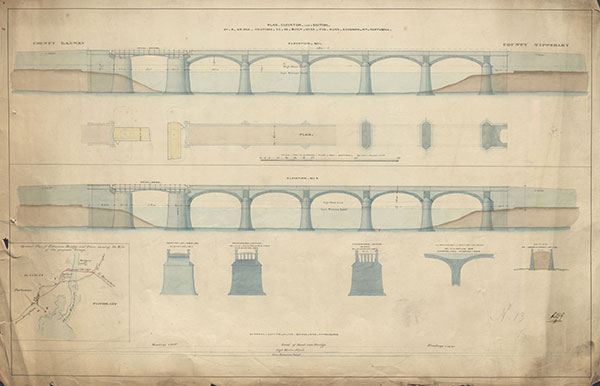Waterways Ireland’s archive goes digital
Published in Issue 5 (September/October 2021), News, Volume 29archive.waterwaysireland.org
By Nuala Reilly
Waterways Ireland has digitised its archive collections, making 200 years of waterways engineering history available to the public through their new digital archive, launched in the summer of 2021. One of the all-island North–South Bodies established under the Good Friday Agreement in 1999, Waterways Ireland is the navigation authority responsible for the seven navigations under its remit: the Lower Bann, the Erne, the Shannon–Erne, the Shannon, the Grand Canal, the Royal Canal and the Barrow. They also have responsibility for the reconstruction of the Ulster Canal from Upper Lough Erne to Clones. On its inception Waterways Ireland inherited an archive collection of engineering drawings from the Office of Public Works in Dublin and a physical archive was duly established in the new headquarters in Enniskillen, Co. Fermanagh.
The archive is home to over 15,000 engineering drawings, maps, charts and photographs, with most of the engineering drawings dating from the middle of the nineteenth century. While the archive is open to the public by appointment with the Archivist during office opening hours, many items rarely see the light of day. The creation of the new digital archive has changed that, allowing researchers and enthusiasts alike free access to the collections. With an easily navigable website, the digital archive showcases four collections: the Engineering Collection, the Delany Photographic Collection, the Ian Bath Collection and the Hayden Collection.
The Engineering Collection contains the drawings from the nineteenth-century Shannon Commission, the Board of Works and the Grand Canal Companies. These drawings, most of which are of the River Shannon, are the backbone of the archive, as they are a record of the attempts to make Ireland’s waterways more navigable for the easy transportation of goods. There’s little doubt that without the contributions of the engineers like Thomas Rhodes, William Mulvany and Henry Renton the Shannon would not be as easy to navigate today, for it was they who engineered the much-needed removal of shoals and rocks, excavated shallow channels, and installed the many locks, weirs and bridges that we know and recognise. The intricate detailed drawings, many with handwritten instructions and notes by the engineers, have all been carefully stored, catalogued and digitised. They also include some interesting non-waterway-related drawings, for example a group of drawings relating to the destruction of Fort Bomarsund on the Island of Aland in the Crimean War of 1854.

Above: ‘Plan, elevation and section of a bridge proposed to be built over the River Shannon at Portumna’ (1837). This particular bridge was never built. Another design was used instead and a bridge built in 1841 further to the south, straddling an island in the middle of the Shannon. (Waterways Ireland)
The Delany Photographic Collection was donated by well-known waterways historian Ruth Delany, who amassed an extensive collection of imagery over the years while researching her many publications on the history of the different waterways. The collection also features photographs of boat rallies in which Ruth and her family participated as active members of the Inland Waterways Association of Ireland (IWAI), highlighting the importance of keeping the waterways open and navigable, as well as personal boat trips and journeys the length and breadth of the waterway system, often taking in abandoned and long-forgotten canals.
The digital archive also features the transparencies from the Ian Bath Collection, a photographic record of the efforts of individuals like the late Dr Ian Bath and voluntary group the Royal Canal Amenity Group (RCAG) to campaign extensively for the restoration of the Royal Canal. This was finally realised in 2010 with its official reopening by Waterways Ireland. In his lifetime Dr Bath collected thousands of images and records, meticulously creating a database of material documenting the Royal Canal over 40 years.
Other features on the website include short film footage of various activities of the RCAG, mostly from the 1980s, donated by the family of the late Charlie Hayden. Boat pushes, sponsored walks, boat trips and volunteer parties installing lock gates are all beautifully captured by Charlie on cine-film, which was recently converted and adapted for online use.
The personal histories and stories of the waterways are brought to life, with over 180 oral history audio clippings available. Retired Grand Canal Dock Master George Brierly fondly recalls growing up in 1940s Dublin, swimming in the River Dodder, and talks about his first job on the docks in 1963, while Jim Gill recounts the harsh life of a ‘greaser’ on the Barrow.
The digital archive will continue to expand and be updated with new material as it is catalogued and digitised. Increasing the online content will provide greater opportunities for researchers and enthusiasts interested in the inland waterways. Ultimately the digital archive will help to preserve these records for many years to come. Users can explore the digital archive using the online catalogue, which puts more than 12,000 items of content right at your fingertips. Search for items using waterways, date range and key words and prepare to go down the rabbit hole.
Nuala Reilly is Waterways Ireland’s Archivist.
















